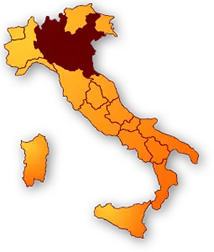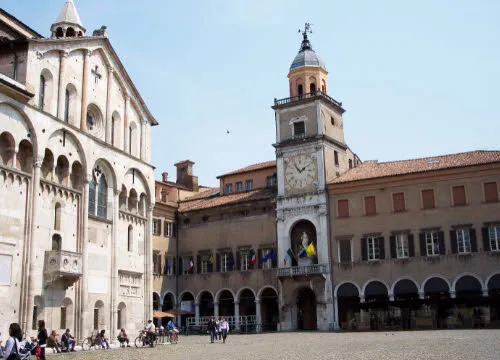Published:
Author: Antonio Maria Guerra
Cotechino

Cotechino is a type of Italian sausage, heir to a millennial tradition that some experts trace back to the ancient Egyptians. Prepared with pork meat and rind, it comes in different variations, depending on the production areas. The most famous is undoubtedly the one from Modena. Let’s find out the history of this specialty, how is made, and many curiosities, with the precious help of its most traditional producers.

What is Cotechino?
‘Cotechino’ is a particular type of sausage, consisting of a mixture of pork meat, fat, rind, salt and various seasonings (*1), stuffed in the intestinal skin of the animal itself (*2). Cylindrical in shape, it looks like a large salami. The specialty is part of the gastronomic tradition of many Italian regions, presenting in each of them different characteristics. Cotechino Modena is, at the moment, the only one recognized by the European istitutions with the assignment of the IGP mark (Protected Geographical Indication): this makes it, de facto, the flag bearer of a very ancient tradition.

Cotechino Modena
THE MOST TRADITIONAL PRODUCERS
This article is the result of collaboration between WebFoodCulture and the Consorzio Zampone e Cotechino Modena IGP: organization gathering the most traditional producers of the specialty.


The history of Cotechino sausage.
The technique of stuffing pork meat into the intestinal skin of the animal is incredibly ancient (*1). This would explain why it’s so difficult to study the past of ‘Cotechino’, one of the most famous Italian sausages.
Some scholars have recently hypothesized that his place of origin could be the Friuli-Venezia Giulia region, the birthplace of another, very similar product: the ‘Musetto’ (*2). What we know for sure is that Cotechino was already prepared in the 16th century by the Guild of ‘Salsicciai’ of Modena (*3): it was since that period, if not earlier, that the name of the specialty started to be associated to the Emilian city.
The fame of the delicacy grew considerably during the 1700s and 1800s. Its definitive consecration took place in 1999 with the attribution of the IGP mark to Cotechino Modena which became, de facto, the most representative type of a product available in many Italian zones.
Notes:
*1: Many historical sources attest that sausages were part of the diet of the ancient Egyptians (as of both the Greeks and the Romans sometime later);
*2: It’s important to remember that ‘Musetto’ is also part of the Venetian culinary tradition;
Modena, the city of Cotechino sausage.
Although opinions regarding the birthplace of Cotechino are sometimes conflicting, when it comes to tradition, the place of reference for this specialty is undoubtedly the Italian city of Modena (and its province).
Read more
This city, located in the Emilia-Romagna Region, can boast very ancient origins: suffice it to say that in 183 BC it was a Roman colony. The greatest recognition of its historical importance is represented by the inclusion of its Cathedral, the Civic Tower (the ‘Ghirlandina’) and Piazza Grande in the list of Italian World Heritage Sites by UNESCO.

How Cotechino sausage is made?
Here follow the steps of the preparation of Cotechino Modena PGI (*1):
1) The procedure begins with the grinding of pork rind and meat (taken from its striated musculature) (*2):
2) Continues with the mixing (*3) of the minced meat with pork fat, salt and pepper (*4);
3) The mixture is stuffed into the intestinal skin of the pig.
Cotechino Modena is sold fresh, after drying (*5), or cooked (*6).
Notes:
*1: Information taken from the Production Specification;
*2: Molds with holes are used for the muscular parts (7 to 10 mm in diameter) and for the rind (3 to 5 mm in diameter);
*3: The mixing takes place in special vacuum machines;
*4: The Production Specification involves also the use of wine, water, aromas and flavoring substances, spices, aromatic plants, sugar, potassium sodium nitrite, ascorbic acid and glutamate;
*5: The drying takes place in special air stoves;
*6: The cooking generally takes place in water. Once ready, Cotechino is packaged in special airtight containers;
Cotechino Modena IGP in video.
An interesting video produced by the Consorzio Zampone e Cotechino Modena IGP shows the preparation of a tasty dish based on Cotechino Modena PGI.

Cotechino and Zampone: differences.
‘Zampone’ is a kind of sausage closely related to Cotechino. The two specialties, in addition to sharing much of their tradition, are very similar to each other except in appearance: although the mixture of both contains, more or less, the same ingredients, in the case of Zampone this mixture is stuffed inside the rind of the pig’s foreleg, while in the case of Cotechino it’s stuffed in the intestine skin of the animal.

The variants of Cotechino sausage.
Cotechino Modena, having received the ‘imprimatur’ represented by the Protected Geographical Indication (PGI), can be considered, in a way, the standard-bearer of a specialty counted, in different forms, among the Traditional Agri-food Products (PAT) of many Italian regions. Here follow a shortlist of some of the most famous:
Read more
- ‘Cotechino Molisano’ P.A.T. : Produced in Molise, it’s flavored, among other things, with orange peel, bay leaf and fennel seeds;
- ‘Cotechino Piccolo’ P.A.T. (o ‘Piacentino’): Produced in Piacenza and its province, it’s flavored, among other things, with cinnamon and nutmeg;
- ‘Cotechino di Maiale del Trentino Alto Adige’ P.A.T.;
- ‘Cotechino di Trecenta’ P.A.T.: Produced in Trecenta (province of Rovigo);
- ‘Cotechino di Puledro’ P.A.T.: Produced in Padua and its province, it’s prepared using a mix of foal and pork meat;
- ‘Cotechino Pavese’ P.A.T.: Produced in Pavia and its province, it’s flavored, among other things, with Marsala wine, aniseed and vanilla;
- ‘Cotechino Cremonese Vaniglia’ P.A.T.: Produced in Cremona and its province. ‘Vaniglia’ (‘vanilla’) indicates the sweetness of the sausage;
- ‘Cotechino della Bergamasca’ P.A.T.: Produced in Bergamo and its province;
- ‘Cotechino Bianco’ P.A.T.: Produced in Valchiavenna and Valtellina, stands out for its pale color;

What is ‘cured meat’?
Cured meat (in Italian ‘insaccato’), is a kind of food prepared by stuffing a mixture of minced meat, fat, herbs and spices in the intestinal (or synthetic) skin of an animal. It can be raw (such as salami and Cotechino) or cooked (such as wurstel and Mortadella).

Cotechino Modena PGI, the production areas.
 Although some scholars speculate that Cotechino is originally from the Italian region of Friuli-Venezia Giulia, it’s undeniable that great part of the tradition of this specialty is closely related to the city of Modena and its province. This was, most likely, the reason for the assignment (*1) of the Protected Geographical Indication (PGI) to ‘Cotechino Modena’ by the European Union. However, it should be emphasized that this sausage is part of the gastronomic culture of many other places in northern Italy (and not only), hence the inclusion of the following provinces in the list of authorized production areas (*2): Modena, Ferrara, Rimini, Forti, Bologna, Reggio-Emilia, Panna, Piacenza, Cremona, Lodi, Pavia, Milan, Varese, Conio, Lecco, Bergamo, Brescia, Mantua, Verona and Rovigo.
Although some scholars speculate that Cotechino is originally from the Italian region of Friuli-Venezia Giulia, it’s undeniable that great part of the tradition of this specialty is closely related to the city of Modena and its province. This was, most likely, the reason for the assignment (*1) of the Protected Geographical Indication (PGI) to ‘Cotechino Modena’ by the European Union. However, it should be emphasized that this sausage is part of the gastronomic culture of many other places in northern Italy (and not only), hence the inclusion of the following provinces in the list of authorized production areas (*2): Modena, Ferrara, Rimini, Forti, Bologna, Reggio-Emilia, Panna, Piacenza, Cremona, Lodi, Pavia, Milan, Varese, Conio, Lecco, Bergamo, Brescia, Mantua, Verona and Rovigo.
Here follow some images showing the city of Modena:
Notes:
*1: Occurred in 1999;
*2: This list is part of the Product Specification document of Cotechino Modena PGI;

Cotechino: calories and nutritional values.
One hundred grams of Cotechino Modena PGI contain about 320 kcal. The sausage has a high content of noble proteins, as well as being rich in B vitamins. Most of the fats are unsaturated. As for minerals, there are mainly zinc and iron.

The wine for Cotechino sausage.
There are few doubts about the right wine to pair with a tasty Cotechino: the best choice is a dry Lambrusco di Sorbara. Its acidity (freshness) and effervescence are ideal to balance the fatness and greasiness of the specialty.

Fresh and precooked Cotechino sausage.
Cotechino Modena PGI is marketed in two types: ‘fresh’ and ‘precooked’. The fresh one should be eaten shortly after purchase and requires prolonged cooking (which generally takes place in water). Precooked Cotechino, sealed in airtight containers, can be stored for a long time.

Cotechino sausage and lentils.
Although Cotechino can be accompanied by many types of side dishes such as mashed potatoes, beans, or sauerkraut, the ‘classic’ combination, generally offered on New Year’s Day, is the one with lentils. This particular legume is considered very auspicious, especially from an economic point of view.
Read more
In Italy there are many varieties of it, such as, for example, the Lentils of Castelluccio di Norcia (PGI), those of Altamura (PGI), those of Villalba, and those of Ustica.

The PGI Indication and the Product Specification document.
The European Union assigned the Protected Geographical Indication (PGI) to Cotechino Modena in 1999. This attribution represented, de facto, the formal recognition of the product’s originality and its close connection to a particular territory.
Read more
The characteristics of the specialty (its ingredients, areas of production, preparation method, etc.) were codified in a specific Product Specification document, whose compliance is guaranteed by the Consortium Zampone and Cotechino Modena PGI.

Cotechino: the origins of the name.
‘Cotechino’ (‘Cùdghèin’ in Modenese dialect) takes its name from the Italian word ‘cotica’, meaning ‘rind’, the skin of the pig. It’s not surprising, since rind is, in fact, one of the main ingredients used for the stuffing of this exquisite specialty.

Cotechino and poetry.
The qualities of Cotechino are celebrated by the Modenese poet Tigrinto Bistonio in one of his works: ‘Gli Elogi del Porco’ (1761). The artist, mentioning the specialty, writes:
Read more
“Ah, cotichin, null’altra a te somiglia
in fragranza e in sapor vivanda eletta!
Quando tu giungi inarca ognun le ciglia.
I grati effluvi ad assorbire in fretta
si spalancano i tubi ambo nasali
e un “Oh” comune il godimento affretta”.
“Ah, cotichin, nothing else resembles you
Food chosen for its fragrance and flavor!
When you arrive, everyone raise the eyebrows.
Both nasal tubes open wide
To quickly absorb your grateful scents
And a common “Oh” anticipates the enjoyment”.

Consorzio Zampone e Cotechino Modena IGP: contacts.
Address: c/o Assica – strada pal. Q8 20089, Rozzano (MI)
Official website: www.modenaigp.it
Mail: info@modenaigp.it
Tel.: +39 02 8925901
FAX: +39 02 57510607
Copyright information.
The images displayed in this page belong to WebFoodCulture and to the Consorzio Zampone e Cotechino Modena IGP, with the exception of:
Public Domain images
- PGI Logo (Wikipedia Link);




